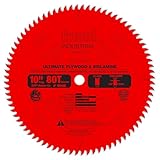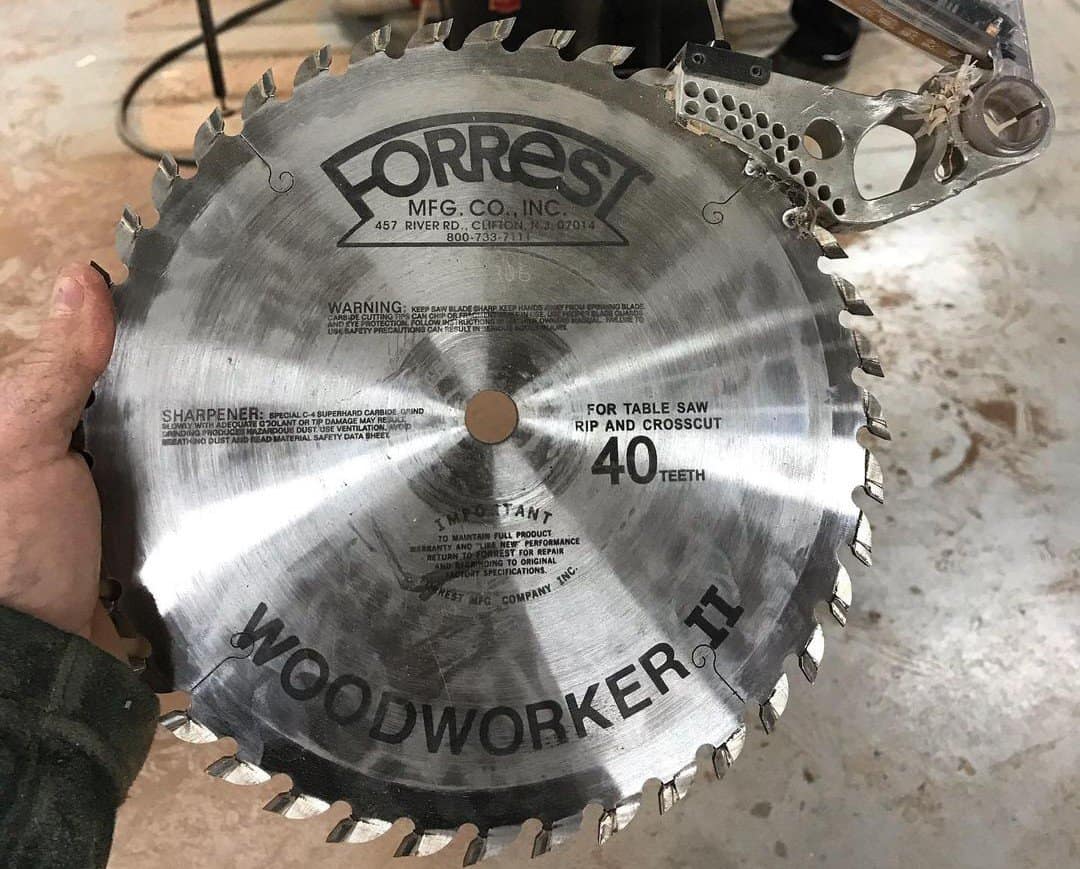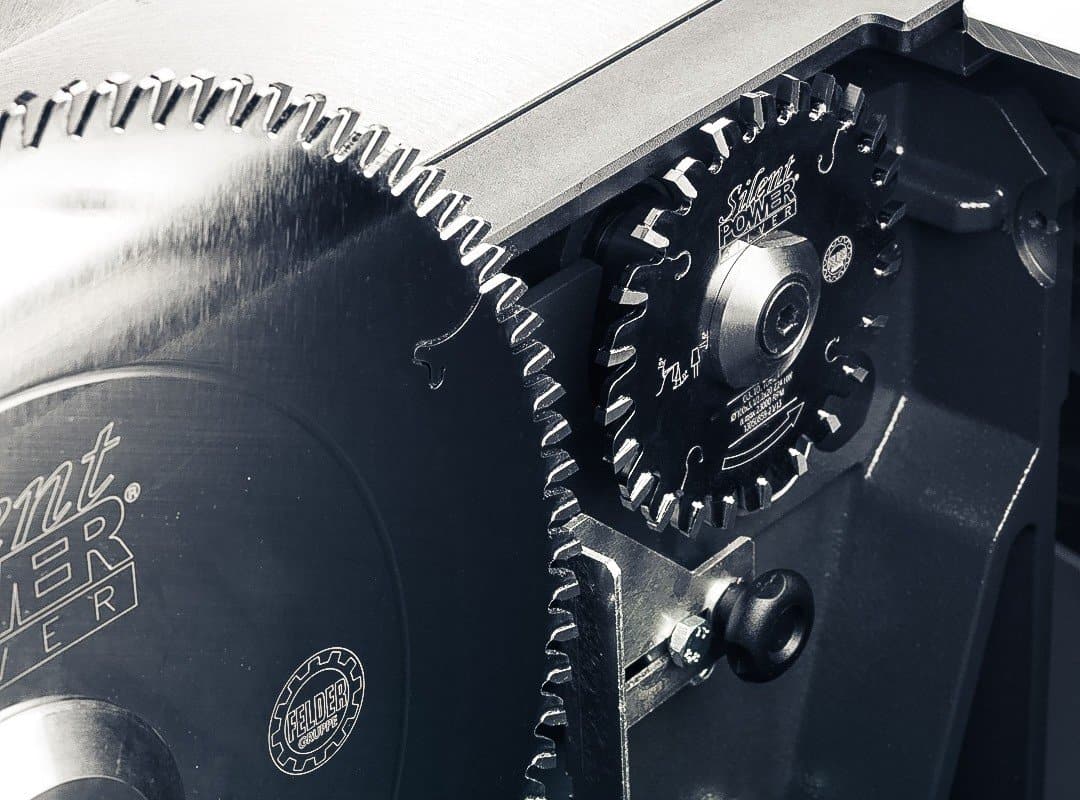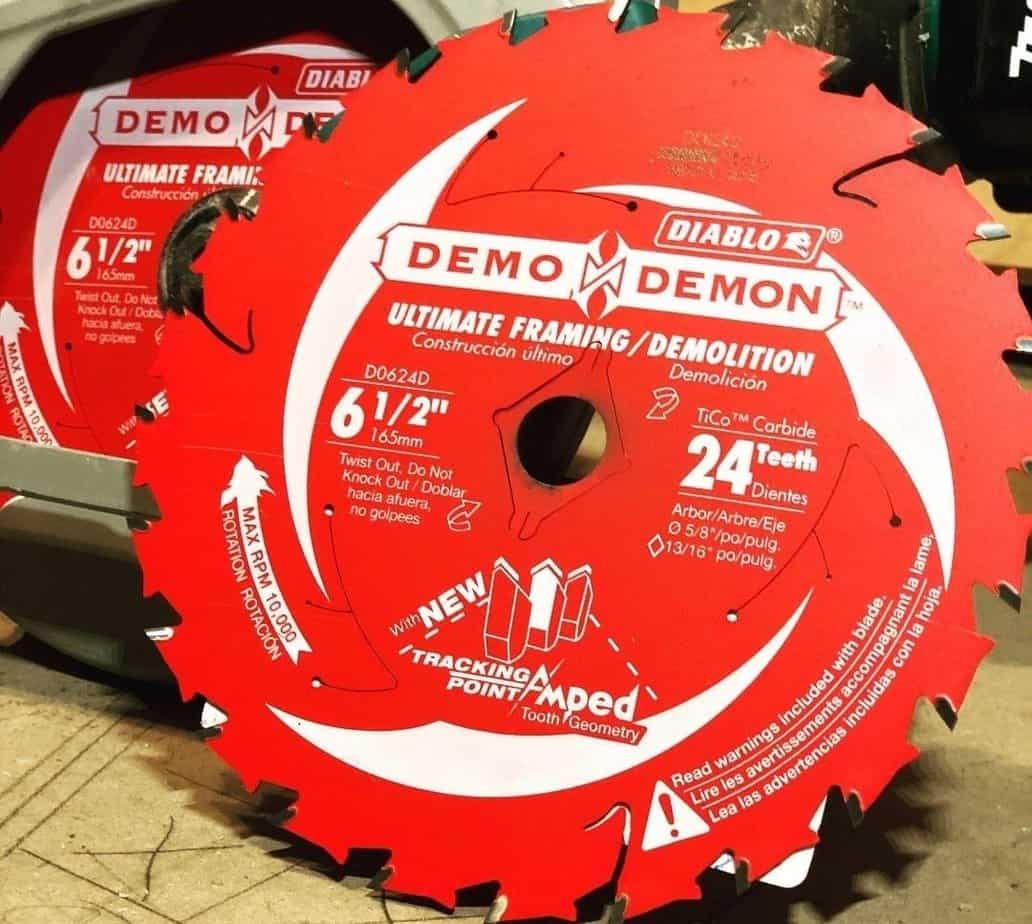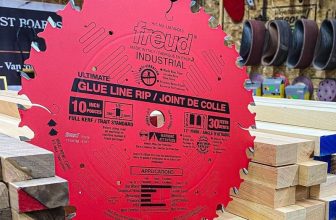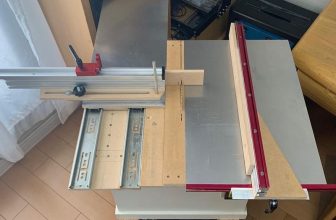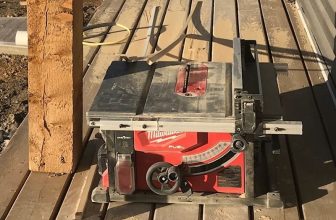10 Best Table Saw Blades to Buy in 2025
Many carpenters call a table saw their favorite and most requested tool. It is not surprising since we use this device for many processes in the workshop. One of the essential elements of this tool is the disk, which depends on the efficiency of work.
After a thorough examination of the best table saw blade options, I settled on the DEWALT DW3106P5 model. Table saw blade reviews might help you determine what you should pay attention to when choosing them. I’ve made a list of top models and advice to support you on this path.
Contents
- 1 10 Best Table Saw Blades Reviewed
- 1.1 DEWALT DW3106P5: Best Table Saw Blades Double Set
- 1.2 Freud LU80R010: Best Table Saw Blade With Non-Stick Coating
- 1.3 Forrest WW10407125: Best Table Saw Blade for Art Woodworking
- 1.4 Diablo by Freud D1050X: Best Table Saw Combination Blade
- 1.5 Makita A-93681: Best Table Saw Blade for Ultra-Fine Processing
- 1.6 Freud-Diablo P410: Best Table Saw Blade With HiATB Teeth
- 1.7 Forrest Woodworker II X: Best Table Saw Blade With ATBR Geometry
- 1.8 Amana Tool PR1040C: Best Table Saw Blade for Active Cutting
- 1.9 DEWALT DW7140PT: Best Table Saw Blade for Precision Trim
- 1.10 Oshlun SBW-100024: Best Table Saw Blade Rip-Only
- 2 Types of Table Saw Blades
- 3 Buyer’s Guide on Table Saw Blades
- 4 FAQ on Best Table Saw Blades
10 Best Table Saw Blades Reviewed
- DEWALT DW3106P5 — Top Pick
- Freud LU80R010 — Runner-Up
- Forrest WW10407125 — Premium Pick
- Diablo by Freud D1050X
- Makita A-93681
- Freud-Diablo P410
- Forrest Woodworker II X
- Amana Tool PR1040C
- DEWALT DW7140PT
- Oshlun SBW 100024
For each type of work, there is usually a different type of blade that allows you to perform the cut as best as possible. By using something that is not designed for this material, you might damage not only the workpiece and the tool but also injure yourself. Also, you can find versatile models on the market. Read on to learn more about top table saw blades.
DEWALT DW3106P5: Best Table Saw Blades Double Set
Specification
- Brand: DEWALT
- Blade Material: Blend
- Product Dimensions: 14.7 x 11.4 x 0.6 inches
- Weight: 3 pounds
The world-famous brand of power tools never gets tired of optimizing solutions for home artisans and large construction companies. This time, the manufacturer presents a set of two 10’’ 7-degree ATB blades, my top pick on this list. They are designed to meet the most popular needs when working with a table saw.
This excellent set includes a 60-tooth blade for cross-cutting and a 32-tooth cutting one for working with softwood, hardwood, MDF, veneer, and plywood.
I was satisfied using them and especially appreciated the fine cut. I often work with exclusive, pricey wood. Thanks to the 60-tooth blade, I can use my materials sparingly. The blades of this line are made of stronger tungsten carbide and balanced with the help of a computer.
I can count on less vibration using them, which means greater accuracy. However, the second blade rarely has a rest with my volume of the job as well. I use it actively, and it stays in good condition.
- Double set;
- Patented wedge shoulder for strength and precision;
- Computer-balanced;
- Durability thanks to construction-grade carbide;
- Expansion slots prevent overheating.
- epending on the type of work, the blades might quickly dull;
- The blade with 32 teeth might make a somewhat rough cut.
Freud LU80R010: Best Table Saw Blade With Non-Stick Coating
Specification
- Brand: Freud
- Blade Material: Blend
- Product Dimensions: 10.2 x 10.15 x 0.65 inches
- Weight: 1.98 pounds
Freud has been one of the industry’s leading brands for 50 years. All thanks to the invention of the ultra-strong alloy MicroGrain Carbide with titanium. Every tool made in its factory has a specific application. This allows you to maximize its performance and extend the service life.
This rip blade is an improved model of Freud’s F810, with a non-stick coating to reduce heat build-up. This innovation also helps to protect the gloss from corrosion and resin. My colleague is a big fan of this tool due to its safe cover. According to the brand recommendation, he extensively uses it for plywood, melanin, laminate, and crosscutting in hardwood.
He confirms the HiATB design with 80 teeth guarantees a near-perfect chip-free cut, and it is what you need in woodworking first.
- Anti-vibration slots;
- High performance due to TiCo high-density carbide tips;
- Perma-Shield non-stick coating to reduce heat build-up and friction.
- If you are looking for a blade for hardwood cutting, it is better to choose another option.
Forrest WW10407125: Best Table Saw Blade for Art Woodworking
Specification
- Brand: Forrest
- Blade Material: Carbide
- Product Dimensions: 11 x 11 x 1 inches
- Weight: 2.18 pounds
Forrest Manufacturing is a family-owned company founded in 1946 that specializes in saw blades. It has developed many innovations and patented the process of creating cutting edges, combining grinding technologies with manual straightening of plates. What makes this tool special?
I got the answer to this question from my uncle. This 10″ model has 40 incredibly sharp teeth and allows him to expertly cut through hardwood, creating clean edges on both ends of the surface.
He admires 30-degree ATB with a 5-degree face hook that provides an almost polished effect for his workpieces. However, as a thrifty man, he particularly likes the following thing: If your saw becomes dull, you may return it to the manufacturer for sharpening.
- An excellent choice for detailed cuts;
- The effect of polishing the cut;
- Sharpening services from the manufacturer;
- Handwork.
- High price;
- The blade might vibrate.
Diablo by Freud D1050X: Best Table Saw Combination Blade
Specification
- Brand: Freud
- Blade Material: Blend
- Product Dimensions: 1 x 1 x 1 inches
- Weight: 4.8 ounces
The Diablo by Freud line of blades has conquered carpenters and builders worldwide with its razor-sharp cuts, and I am no exception. This model boasts 50 strong ATB teeth in a combination configuration arranged in groups of 5 teeth.
This solution makes it possible to use the blade both for longitudinal and transverse cuts. Thanks to such versatility, you can save time working without changing blades.
However, I used this product and noted some nuances there. It might quickly rip through hardwood, ejecting a lot of sawdust through the large tooth gullet. When I did crosscut, the blade handled it harshly, leaving a bit of an untidy mark. Talking about the benefits, I ensured this blade is better resistant to impacts and blunting (four times as the brand says).
It happens thanks to an exclusive alloy and is protected by a non-stick coating. I was glad that it comes with a bonus, the vents to stabilize and reduce vibration and noise. Working with it is surprisingly pleasant and stress-free. The blade has Freud’s Limited Lifetime Warranty.
- Versatility;
- Freud’s exclusive shock-resistant TiCo Hi-Density Carbide formula;
- Thermal expansion and ventilation slots;
- Perma-Shield protects against heat and corrosion.
- The cross-section could have been neater.
Makita A-93681: Best Table Saw Blade for Ultra-Fine Processing
Specification
- Brand: Makita
- Blade Material: Carbide
- Product Dimensions: 12 x 11.8 x 0.2 inches
- Weight: 1.75 pounds
The Makita was established back in 1915 to sell and repair engines. Today, the powerful, innovative products of this experienced corporation can be seen on almost every construction site and workshop. This elegant model of the rip blade is another confirmation of the high quality of its products.
The accessory has 80 micro-grained hard alloy teeth arranged according to the ATAF (Alternate Top Alternate Face) scheme. This blade became my first experience using such a teeth configuration. I should admit that I felt comfortable during the work and saw great results in the end.
Together with the Japanese ultra-thin 0.91″ cut design, this guarantees ultra-precise cross-cutting in hardwood, softwood, and plywood. Also, I’ve used it with a miter saw and can say the blade might be the perfect accessory for it.
- A good choice for high-quality product processing;
- Micro-grained hard alloy;
- High-precision cutting with a polishing effect;
- Hardened and hand-tensioned steel plates.
- The blade is very sharp: beginners should use it with extreme caution.
Freud-Diablo P410: Best Table Saw Blade With HiATB Teeth
Specification
- Brand: Freud
- Blade Material: Blend
- Product Dimensions: 10.35 x 10.05 x 0.65 inches
- Weight: 2.28 pounds
P410 Premier Fusion from Freud is called a new generation ripping blade for a good reason. The all-new Fusion Trio Tooth design is a 40-tooth 30-degree HiATB configuration. I tested this unit in a friend’s workshop and ensured that the TiCo Hi-Density carbide provided a sharper edge.
In addition, the dual side grinding design allows for smooth polishing cross cuts, and the Axial Shear Face Grind cuts through wood and sheet metal with minimal resistance. Since this is a general-purpose blade, you can use it for sawing laminate, melamine, veneered plywood, softwood, and thick lumber.
- Dual-purpose;
- TiCo Hi-Density hard alloy for perfect processing;
- Anti-vibration gaps;
- Perma-Shield non-stick coating for corrosion protection.
- Burns might remain on the cut after sawing;
- It is better not to use hard rocks, for example, oak.
Forrest Woodworker II X: Best Table Saw Blade With ATBR Geometry
Specification
- Brand: Forrest
- Blade Material: Stainless Steel
- Product Dimensions: 10.95 x 10.9 x 0.4 inches
- Weight: 2.02 pounds
This is another version of the legendary Woodworker II. This 10-inch model is designed to meet your carpentry needs for a sharp cut. Working on one project, I made sure that it was capable of cutting even red oak.
The blade features 20 C-4 carbide teeth that last up to 300 percent longer between sharpenings. The ATBR (Alternate Top Bevel with Raker) geometry is a group with four teeth in an ATB configuration, and the 5th tooth is a flat top rake for sawdust raking.
I like testing blades with various tooth configurations. My project included different types of cutting, and I noted with pleasure that this shape was optimized for cross-sections and also showed itself well on spraying.
This model is a worthy choice despite its non-budget price because it is a good investment from a long-term perspective. Forrest kindly accepts the blades for sharpening when they go dull.
- Multipurpose purpose;
- Optimized ATBR tooth geometry;
- Long use without re-sharpening.
- After sawing, you likely need sanding;
- The price is higher than other models in this category.
Amana Tool PR1040C: Best Table Saw Blade for Active Cutting
Specification
- Brand: Amana Tool
- Blade Material: Carbide
- Product Dimensions: 5.75 x 2 x 0.75 inches
- Weight: 0.036 ounces
The Amana Tool has been in the cutting tool market for 40 years and is an expert in manufacturing industrial quality carbide accessories. However, that does not mean you can not use its products at home. The Prestige series’s universal blade is designed to cut hardwood, plywood, MDF, and chipboard.
It has 40 ground teeth, ground at an angle of 20 degrees, a massive 102″ thick tool steel plate, and carbide tips for productive work. The 18-degree hook angle guarantees easy feeding.
To optimize the process, the rip blade has expansion slots and copper plugs that cope well with vibration and noise. This is an excellent option for cutting large workpieces from hard materials on saws with more than 3 HP power.
- Universal blade;
- Strong plate 102″ thick;
- ELECTROBLU non-stick coating to reduce the accumulation of heat and resin;
- Compatibility with the SawStop safety system.
- The blade might be too thick for low-power saws.
DEWALT DW7140PT: Best Table Saw Blade for Precision Trim
Specification
- Brand: DEWALT
- Blade Material: Blend
- Product Dimensions: 11 x 0.45 x 13.2 inches
- Weight: 1 pounds
The DEWALT DW7140PT is a 10″ ripping blade with 40 chunky teeth in an ATB configuration. Despite the low price, this blade is not inferior to competitors in quality.
The accessory is designed for ripping and crosscutting. Its teeth are made of premium micro-grain carbide, grounded and polished to a mirror finish on all sides, and have incredibly sharp cutting edges.
Passing through the material, the blade leaves almost no splits. The balanced body and damping slots that reduce vibration are responsible for the accuracy of cuts. The brand has also taken care of durability, and I am pleased with the accessory that provides such a long lifespan. It has a Tough Coat Finish to extend the blade’s life, which allows you to reduce heat and friction.
- Multi-purpose purpose;
- Depreciation;
- Tough Coat Finish;
- Compatibility with the SawStop safety system.
- The blade might deform.
Oshlun SBW-100024: Best Table Saw Blade Rip-Only
No products found.
Specification
- Brand: Oshlun
- Blade Material: Carbide
- Product Dimensions: 10.8 x 10.6 x 0.6 inches
- Weight: 8 ounces
The Oshlun SBW-100024 model is last on the list but not least in terms of performance. My neighbor Nick chose it for home renovation and got an industrial-quality rip blade at an affordable price for all his cutting needs.
This blade has 24 very sharp teeth in ATB configuration and is created for ripping all types of hardwood, softwood, and plywood.
The alloy steel plate is fully hardened, grounded, and tensioned, and the teeth have micro-grain carbide tips. To reduce vibration and noise, expansion slots and copper plugs are provided on the blade. These features ensure a smooth work process, so the renovation next door was successfully completed.
- Anti-kickback design;
- Aggressive hook angle;
- Professional-grade carbide;
- Tensioned and hardened steel plate;
- Affordable price.
- The cut edge will likely have teeth marks and need sanding.
Types of Table Saw Blades
The ripping blade is perhaps a table saw’s most critical variable element. You should take it seriously when choosing and installing it because the quality of work and your safety depend on it. Using the correct blade type ensures a clean, neat cut, while the wrong blade might mess things up. Consider the most popular types of table saw blades.
Crosscut
Such blades will come in handy if you plan to make a perpendicular cutting of the workpiece. A transverse blade has more teeth and is usually slower than a ripping blade. However, you might expect cleaner, neater, smoother cuts.
Since there is less space between the teeth, the blade removes fewer wood fibers during operation. It is worth having it at hand if you need to carry out fine processing of some product, for example, a sheet of plywood.
Flat-tooth ripping and rip-only
Rip-only blades are among the most common ones. They are often the best solution for fast and deep cuts alongside the wood grain. Such disks mostly come with the configuration of flat-tooth ripping teeth, which are perfect for working with solid wood.
However, you should not expect an excessively neat cut when using them. The rip blade has fewer teeth (usually from 10 to 30), so the cut surface looks rougher.
Combination and alternate top bevel (ATB)
The ATB design is a blade in which the teeth are beveled with a shallow angle in the opposite directions: A tooth beveled to the left is followed by a tooth beveled to the right. Such a blade provides a very sharp edge with a minimum number of splits and is used for slow transverse cutting. It is a good choice for working with plywood.
The combination blade predictably mixes flat and beveled teeth. In this hybrid design, there are four alternate top bevels per flat-tooth.
Dado
Dado allows you to make blind grooves in wood, plywood, chipboard, and MDF without chipping more than 1/8” thick. You might adjust the blade’s position and control the groove’s width. There are two types of dado blade:
- The wobble dado blade is characterized by offset rotation. It wobbles during cutting, allowing you to quickly create an individual cut.
- The stacked dado blade is several blades assembled into one broad blade. They are interspersed with spacers to create a more precise cut.
Before starting such work, I recommend you study the characteristics of your saw because not all models support the installation of dado blades.
Buyer’s Guide on Table Saw Blades
A table saw is probably an indispensable tool in construction or renovation. With its help, you can transform various materials into new things, from plywood and wood to plastic and metal. The hero of these processes is the blade, selected according to the planned work. Below I will consider the main characteristics of a rip blade to help you choose one.
Job type
Since wood is the most common material used in the workshop, there are two types of blades according to the type of work:
- Transverse cutting (smaller size of teeth);
- Longitudinal cutting (larger size of teeth).
The fundamental difference between these blades lies in the number and size of teeth, which guarantee efficiency and quality of work. What happens if you mix them up? Using a large tooth saw blade for crosscutting will likely result in an uneven cut requiring additional hand work.
Sawing lengthwise using a blade with small teeth will not only increase your work time but might also lead to other negative consequences. For example, an overheated long-term tool might become inoperable.
It is worth noting that today manufacturers also offer universal blades that can perform all types of tasks that you put before them equally well. However, I still recommend using the appropriate rip blade for each type of work. This might extend the life of your tool and ensure a better result.
Blade kerf
The second important criterion for choosing the best table saw blade is the blade kerf or width of the material removed during cutting. Each project requires a blade with a different cut size. Let’s consider two types of them according to this characteristic:
- Blades with a thin cut
It usually has a typical tooth width of 3/32” and is very economical in machining workpieces. After working with it, you will likely not see a mountain of sawdust. It might be a good helper for cutting thin or exotic wood materials that you would like to use sparingly. It is often used for small jobs on the saws with a capacity of up to 3 HP because this blade does not load the engine. - Blades with a full cut
This blade usually has a width of 1/8”, so it is much stronger and lasts longer than a thin one. In addition, it can withstand heat and not bend during long-term work.
Blade diameter
When choosing the best table saw blade, you should consider its outer and inner diameters.
Outer diameter
It determines the maximum thickness of the material, as well as the maximum speed of rotation of the blade. The larger the diameter, the smaller the circle’s maximum permissible number of revolutions. After all, a larger blade creates a greater load on the device. Here are some examples:
- diameter up to 3.15″ — 23,800 RPM;
- diameter up to 3.94″ — 19,100 RPM;
- diameter 4.72″ — 15,900 RPM;
- diameter 9.84″ — 7,600 RPM;
- diameter 11.81″ — 6,300 RPM.
Inner diameter
The inner diameter should fit the saw pin perfectly. It is worth carefully checking whether the saw holds the blade well since the quality of work and your safety depend on this.
Blade tooth configuration
I recommend choosing the configuration of teeth based on your goals. Let’s consider four main options:
- A tooth with a flat top
These are blades with a flat sharpening, which are used to quickly rip a large amount of material lengthwise. It is a good choice when precision and high quality of work are not required. - Alternate top bevels. In this blade, the teeth are beveled at a slight angle and lean across each other in different directions. This configuration is more suitable for crosscutting.
- Combined teeth. This is a hybrid design in which beveled and flat teeth alternate. Carpenters consider it universal and use it for transverse and longitudinal cutting.
- Trapezoidal teeth. In such a blade, trapezoidal and flat teeth alternate. This configuration does not split the material, guarantees a clean, neat cut, and is recommended for working with laminate.
Tooth gullet
This unusual name hides the curved space between the teeth of the rip blade. Gullet depth is the gap from the tooth’s base to its apex.
The size of the gullet depends on the number of teeth and determines how fast the blade will move and how much sawdust you will have at the end of the workshop. The fewer teeth the blade has, the higher its feeding speed and the larger dimensions of the gullet.
Additional features
A table saw is usually associated with working with wood materials. However, depending on the power of the tool and your needs, you might try to use it for cutting more challenging workpieces or vice versa for more delicate jobs. For this, you will need to purchase special blades:
- Finishing blades
These blades are worth considering if you plan to cut with the smoothest edges possible, especially on plywood materials. - Cutting nails
If wood is reused, cloves might be left in it. These blades have to handle such surprises. - Metal cutting
These powerful blades will come in handy when you need to cut through steel pipes, metal sheets, etc. - Dry diamond
This type of blade is made of synthetic diamond crystals. Artisans use them to cut ceramics and porcelain.
FAQ on Best Table Saw Blades
There are some details that you might want to know about table saw blades. Here are the answers to the most common questions readers often ask me about them.
Are table saw blades universal?
The market offers universal blades that can be used for various types of work. However, to get better results for each task, I recommend using the appropriate types of blades.
What size table saw blades are?
The blade size includes the following indicators: outer and inner diameter, thickness, and the number of teeth. When choosing the best table saw blade, you should consider each of these criteria, as well as the power of the tool. For example, RPM depends on the diameter’s size.
How to clean table saw blades?
For cleaning, I advise choosing specially developed solutions. You should be careful using the popular folk method of cleaning with an oven cleaner. It might deform the blade.
Which Blade Is Ideal?
Both experienced carpenters and beginners in woodwork know that it is difficult to do an excellent job without a good blade. There is a perfect DEWALT DW3106P5 model which effectively performs its tasks. I recommend that you carefully evaluate the work front and choose the correct blade type.
Best table saw blades: comparison table
| Best table saw blades | Job type | Number of teeth | Teeth configuration |
|---|---|---|---|
| DEWALT DW3106P5 | Crosscutting General purpose | 60 32 | ATB |
| Freud LU80R010 | Plywood, melamine cutting | 80 | HiATB |
| Forrest WW10407125 Woodworker II | Ripping, crosscutting | 40 | ATB |
| Diablo by Freud D1050X | Ripping, crosscutting | 50 | ATB Combo |
| Makita A-93681 | Crosscutting | 80 | ATAF |
| Freud-Diablo P410 Premier Fusion | General purpose | 40 | HiATB |
| Forrest Woodworker II X | General purpose | 20 | ATBR |
| Amana Tool PR1040C | General purpose | 40 | ATB |
| DEWALT DW7140PT | Ripping, crosscutting | 40 | ATB |
| Oshlun SBW-100024 | Ripping | 24 | ATB |
Which blade do you use most often? How do you feel about universal models? Share your thoughts in the comments!
“A good tool stays with you for many years and choosing carefully ensures the job is done right, your work is neat, and the tool is always a pleasure to use”

